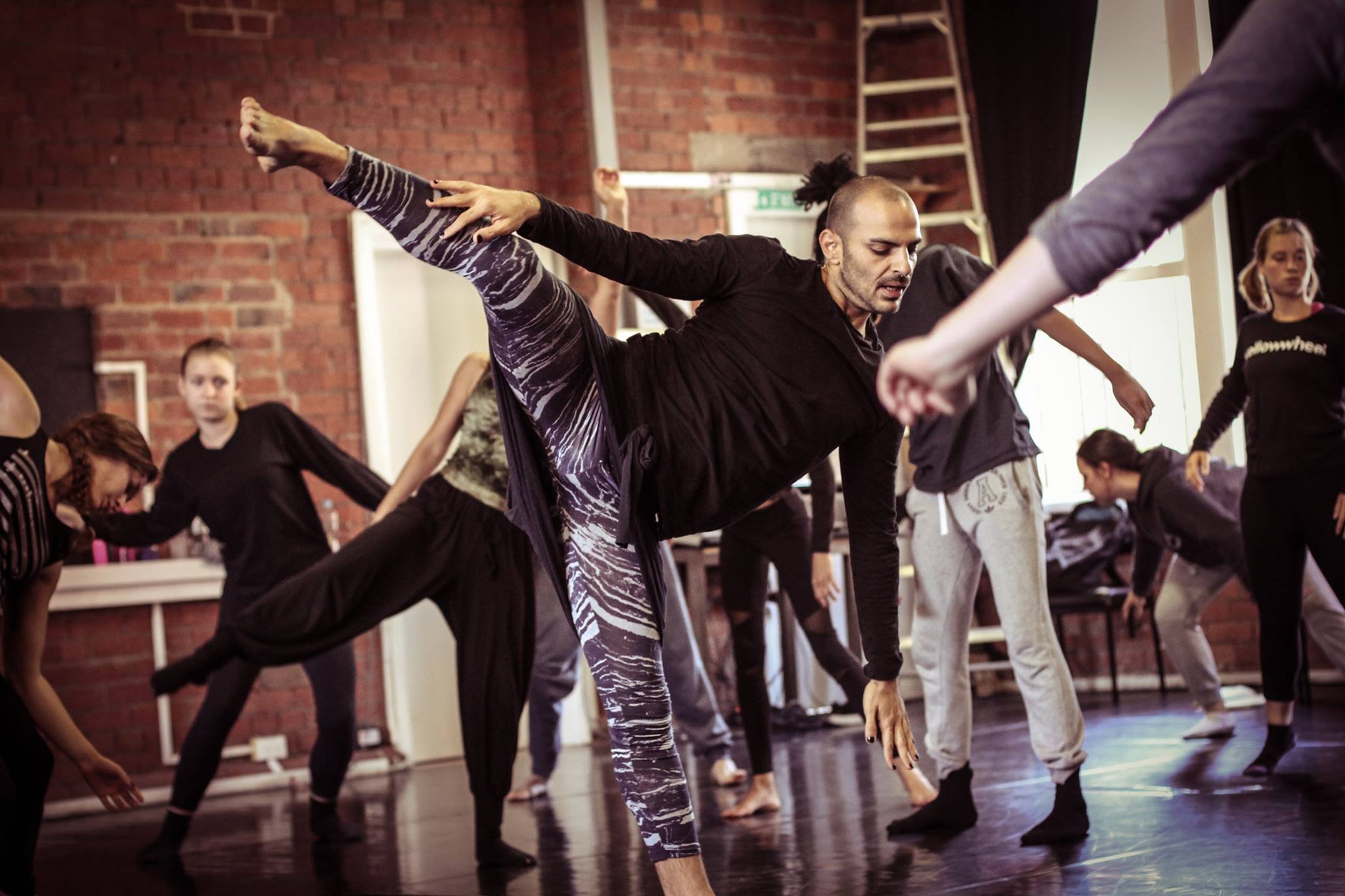“Having ilDance as an identity gave me the last push to respond” - Israel Aloni on 10 years of ilDance | Part 1
As we come to the end of ilDance’s 10-year anniversary, Co-Founder & Artistic Director Israel Aloni gives an insightful interview about ilDance’s development, how it was a response to Gothenburg’s dance landscape and how their own practice has evolved over the years in the first of a two-part interview.
Can you tell us about where you were, professionally and personally, when the concept of ilDance came about?
Israel: There are a few different moments in time that led to ilDance being formed. I invited Lee to come work with me in Gothenburg, I believe it was in 2007, while I was working on the graduation production for Balettakademien in Gothenburg. There were 14 or 15 people performing and I was creating a full evening of work, so I invited Lee to be the choreographer assistant for that process and this led to Lee working with me for three or four years in Sweden.
I had suffered a big injury to my hip while I was working at GöteborgsOperans Danskompani, which required three hip operations in one year. Every doctor, every therapist and every physician said you know you need another career, you will never be able to go back to dancing full-time and I started thinking about other things. I was very close to moving to Italy at some point, to study design in Milan and then it kind of hit me that I never had the experience of living as an adult in Israel. I thought maybe I'll go to Israel and see what it's like to live there.
Photo by Hedda Axelsson
So I took a year off from GöteborgsOperans Danskompani, I went down to Israel and I wasn't supposed to be dancing but very quickly, I think three or four weeks after I arrived, I already had like three or four different dancing jobs. I was involved in projects, I was dancing full-time, I was doing other things as well and became very busy.
Life in Israel was too stressful for me and I decided to go back to Sweden. I called the office at the Opera, saying that I actually don't feel like I want to stay in Israel and whether I could go back even before the end of that year off and they basically said “how quickly can you get back.” I think a week after that phone call, I was already back in Sweden working with them again.
Shortly after I moved back to Sweden, I was also offered a job at Sasha Waltz and guests in Berlin, so I was working as a full-time dancer but already had a distinct way of working as a choreographer. My work with Sasha Waltz is kind of a pivotal moment, I think the way I’m creating now is very different from how I created then.
At that point, I was already choreographing for many years and Lee had worked with me as my assistant for a few years. While I was away, Lee started taking some choreographing work at Balettakademien and also started working on an independent project, so she started experimenting with her choreographic voice. And when I returned to Sweden we said why don't we actually try to choreograph something together. I've had my choreographic practice, she was discovering her choreographic voice, we were working together for a few years already, so let’s try to do something more collaborative in that sense rather than one choreographing and another assisting.
A friend of ours, Daniel Isaksson, was graduating from his International Project Management studies at Kulturverkstan in Gothenburg - he presented this opportunity for his final project, to produce our first production as a creative duo.
As we thought about what to call ourselves, it was clear to us that we wanted the word dance in it because we're quite critical of how easily dance is sort of pushed aside for other terms, terminology that is sort of branching out from dance as if dance cannot evolve in itself so we wanted the word dance in what we call ourselves but we didn’t know what else.
We thought Lee Brummer and Israel Aloni Dance Company, this is a mouthful, Lee and Israel, too personal, OK let’s just call it liDance, then it’s just like Lee Dance, let’s just swap it, ilDance, ah that sounds good, let’s call it ilDance.
We made SOD and premiered in Atalante, we had a full week there, the audience received the work really well and we were quite pleased. It was very new for us to work in that way and it was new for Gothenburg.
Can you remember your viewpoint on the company then? Did you already have something long-term in mind about the project and where you felt it could go?
Israel: It was a little bit like the ketchup effect, once the first squeeze happened, it all splashed out. By that point, I had already been in Gothenburg for 10 years and had been very involved in the dance world and culture in general here, I had been commissioned for different things and presented work at GöteborgsOperan, both for the small stage but also some smaller projects on the main stage. I presented work at Pustervik, which was a venue that does not exist in the same way anymore, now it's more of a concert hall, and I was teaching a lot, so a lot of dancers knew me.
Long story short, having ilDance as an entity, an identity gave me the last push to respond to the kind of dynamic in the ecosystem of the Gothenburg dance scene. Gothenburg didn’t have dance companies, didn’t have independent bodies that are not associated with a venue. I think now we're 10 years later and there are more independent choreographers trying to make things happen for themselves in west Sweden but back then there was the senior generation but not so much the emerging things. Moa Sahlin and Marika Hedemyr had a space, there was 3e Våningen and Atalante then, that was the independent dance sector, but they were attached to venues.
Lee and I noticed this, we were very involved in international contemporary dance and knew that there are other ways of doing things and we wanted to do it as soon as we could. It was really a response to the community and what was necessary because we were educators, we knew there were missing links in the trajectory of emerging artists in Sweden, we were interested in presenting independent artists from abroad in Sweden and in the beginning, we had the ilDance international choreographic competition. We had a jury from different venues and institutions in Sweden and abroad viewing material and the winner of the competition got to be presented in Sweden on tour.
We felt that Swedish audiences, particularly outside of Stockholm and Gothenburg didn’t get to see international independent contemporary dance. We were just responding because we felt capable, able and interested in filling the gaps.
Photo: Adam Wheeler
And that is very much what you did, not just with the competition but with ilYoung, iCoDaCo, creating opportunities for artists and connecting the dance scene within Gothenburg and outside. Did you feel like a facilitator at the time?
Israel: Yes and we were experimenting with a lot of different formats to find what we wanted to do. ilDance is a grassroots, anti-establishment, power-to-the-people, hybrid, non-organisation organisation. It’s a choreographic, dynamic, queer project. Finding ways to connect, with and through contemporary dance in ways which are not predetermined by stakeholders and government bodies.
I think because of the cultural background Lee and I come from, it is very DIY, independent artists where we come from are really the generators of society, they drive things. We are not coming from a background of managers, producers, or curators being the ones calling the shots in the making, artists are the makers. And I think that is what happened, it’s a hybrid mutation of recognising the potentialities of the structures that exist in Sweden but also being stimulated by existing experiences that we had from other contexts.
It started 10 years ago and we are always checking in with ourselves and asking these difficult and confronting questions about why we do this because at the end of the day, Lee and I are artists who want to make work and connect and communicate with the world through it, and how relevant are all these massive undertakings to what we want to do?
So far, we keep on giving ourselves the answer that it is relevant, so we keep on going.
You’ve mentioned before that the philosophy of what you do, on a personal level, has changed a lot over the past 10 years. When you speak and write about your work, the philosophy and inspirations you take are very important. How do you feel that has developed over these years?
Israel: By all means, I am not able to summarise how it has developed but a way it has changed is that I have moved away from an approach that treats the artwork as an object and therefore the people who make the art, which in my world are the dancers, are objectified – so they are means to a purpose, to an end.
Whereas now, I’m much more intrigued, inspired and encouraged by the interest in the subjectivity. The subjectivity of the individuals making the work, the subjectivity of the work as such, the subjectivity of the audience, who are witnessing or experiencing the work, the subjectivity of space and time, which I think also corresponds to the shedding of the concept of perfection or conclusion.
Life is a work in progress, making art is a work in progress, every work is a work in progress. That aspect of life in dance is not intimidating or detrimental in my world, it is perhaps the most interesting thing.
Ephemerality, temporality, it is an instant and a very unique instant – this powerful meeting between the work, the space, the time, the people.
Israel Aloni in Schism | Photo: AdeY
So this is how it mainly changed, I came from a very traditional background of performing dance in large theatres or opera houses, very frontal audiences in the dark, you as a dancer performing to 1200 people but you have no idea who is there, you don’t know them, they don’t know you. You get injured, someone else will do your role. It’s not even when you get injured, there are two or three casts for the same piece, so the audience sees a different version of it not because of an intention to create a different version, but just because of the bureaucracy of the system.
It is very detached, and it was very difficult for me from a very young age, in my early 20s at the Gothenburg Opera, I really lacked the connection with the people and it took me time to find some kind of language to even address it. I think I’m still searching but I have been able to articulate some of these ideas.



